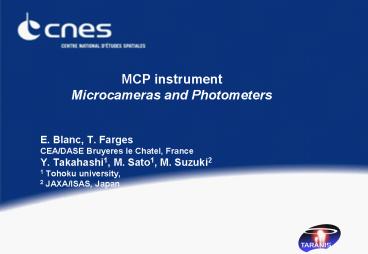MCP instrument Microcameras and Photometers - PowerPoint PPT Presentation
1 / 12
Title:
MCP instrument Microcameras and Photometers
Description:
MCP instrument. Microcameras and Photometers. E. Blanc, T. Farges ... Provide unambiguously the identification, dating and localization of TLEs ... – PowerPoint PPT presentation
Number of Views:36
Avg rating:3.0/5.0
Title: MCP instrument Microcameras and Photometers
1
MCP instrumentMicrocameras and Photometers
- E. Blanc, T. Farges
- CEA/DASE Bruyeres le Chatel, France
- Y. Takahashi1, M. Sato1, M. Suzuki2
- 1 Tohoku university,
- 2 JAXA/ISAS, Japan
2
TARANIS MCP images and waveforms measurement
goals
- Provide unambiguously the identification, dating
and localization of TLEs - (sprites, elves, halos)
- TLE characterization
- global mapping, occurrence rate
- interpretation of all other instruments
- Provide dating and localization of lightning
- characterization of parent lightning
- global mapping, distance lightning-TLE
- source mechanisms
- Provide spectroscopic information (FUV/ UV /IR
emission band) - source mechanisms
- energy determination
- Transmit a trigger information to all Taranis
instruments when a TLE is detected
3
MCP instrument Principe
Photometers TLE and lightning wave forms
Microcameras TLE and lightning images
- TLE characterization and localizationfrom nadir
in absorption band of the atmosphere - Lightning localization
- - Monitoring
- - Identification of lightning contribution in the
TLE images
- Characterization of TLEs and lightning in the
time - Spectroscopy in 3 different TLE emission bands
- Lightning monitoring in a large FOV
- Real time alert of TLE
4
Spectral band selection
Observation bands selected for only Nadir
observations
- ?TLE camera and photometer in NIR 761 nm
- Strong emissions in the N2 1P band
- Encouraging results with LSO for sprite
identification - ?Lightning camera and photometer 600-800 nm
- Strong response expected
- ?TLE photometer in UV 337 nm
- Emission in the N2 2P band, most intense in blue
and UV - Needed for spectroscopy comparison IR and UV
- ?TLE photometer in far UV 150- 280 nm
- Emission in N2 LBH band of far UV (observed by
ISUAL) - Needed for spectroscopy
- Important for triggering (low rate of false
alarms)
Sprite spectrum at source
N2 (0,0) 2P
N2 (3,1) 1P
762.7 nm
337 nm
N2 2P
N2 1P
5
Change from phase A 4 photometers
Phase B
Phase A
Advantages TLE spectroscopy - same FOV of
PH3, PH1, PH2 Triggering of TLE in FUV - lower
false alarm rate Lightning monitoring - in a
large FOV (comparable with other instrument) -
continuous survey mode - observations over SAA
and triggering - same observation band as
lightning camera (TLE/lightning differentiation)
6
Change from phase A PH sampling frequency
FUV (LBH)
UV (N2 2P)
Blue (N2 1N)
red-NIR (N2 1P)
Lightning band
UV-blue (N2 2P and N2 1N)
ISUAL, Mende et al., 2006 Takahashi, 2007
Advantages Better separation of lightning and
TLEs
7
Change from phase A frame rate of the cameras
Mende et al., 2006
Continuous illumination of lightning
A continuous lightning illumination lasting 100
ms produce a strong noise in the images which can
be reduced by short integration time (30 ms
rather than 100 ms)
Advantage Better contrast ? better direct
identification of events
8
Constraints
- Satellite
- Accommodation with Nadir pointing
- Field of view
- MC1, MC2 55
- PH1, PH2, PH3 55
- PH4 100
- TLE and lightning localisation
- Earth pointing with an accuracy better than 0.5
- Attitude restitution better than 0.1
- Geometrical model better than 0.1 on all pixels
of the field of view - Satellite stability of 0.1/s
- Stability lt 0.03 over 250 ms
- Time Precision
- 50 µs relative, 1 ms absolute
- Night observation only
Number of day without observation
60
3 LT
1 LT
40
4 LT
20
geographic latitude
0
-60
Janv
Jul
Dec
MCP latitude coverage during a year for
different satellite local time
9
Archiving modes
Day time
Night time
MC1,2
PH1,2,3
PH4
Time 1 orbit
Event mode
Survey event
Triggering instrument
Continuous survey mode
400x400 pixels instead of 512x512
10
Archiving modes
depending on compression methods (the most
efficient is windowing)
Voss et al, 1998
Example of survey mode with a photometer
11
Camera and photometer characteristics
photometer
camera
analyzers
Changes since PRR phase A review
12
Work to be done in phase B
- Reorganization of the instrument team
- CNES instrument technical responsible
- CEA MCP Needs Requirement, CMS software
- Phase B tasks Instrumentation - engineering
model- interface definition technical
specifications and verification plans - Cameras and analyzer subcontracting
invitation to tender, choice of manufacturers - Photometers Phase B (Japan)
- Phase B tasks Simulations (CEA)
- Based on modeling and ground based
experimentations - Test of different instrument functions































